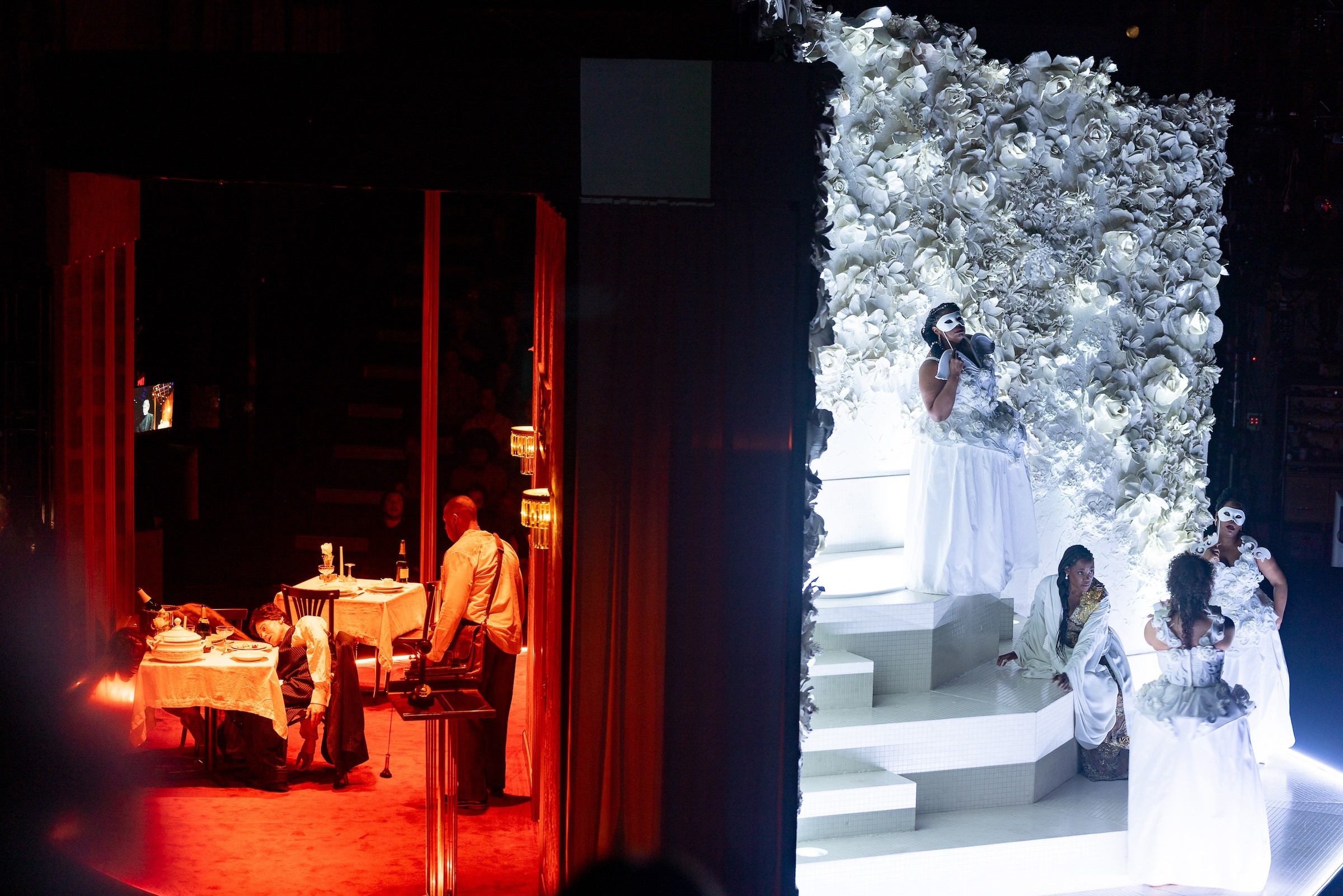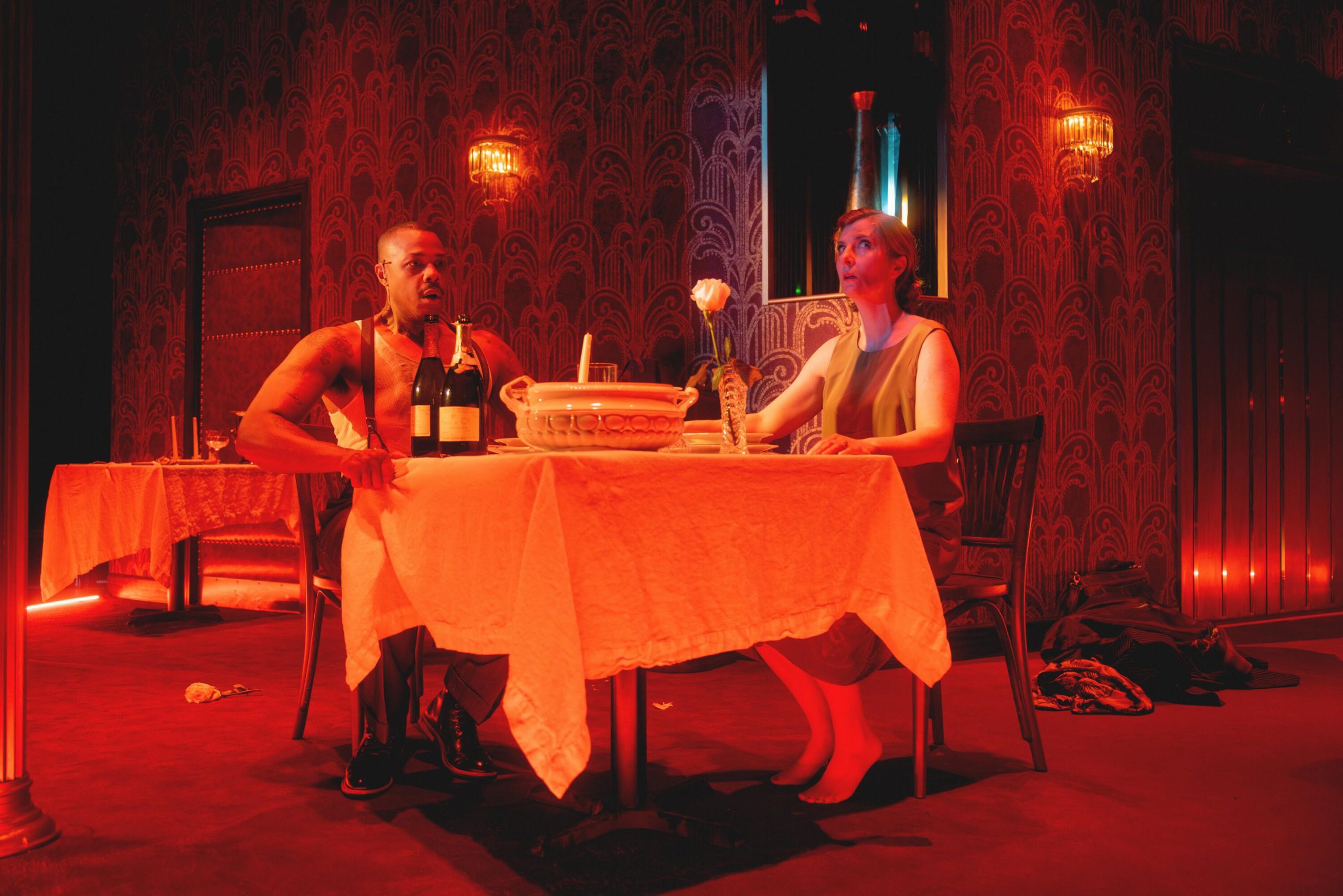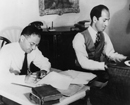Reviews
AMOC Invades Lincoln Center
In Strauss and Hofmannsthal’s Ariadne auf Naxos, an opera seria ensemble and a commedia dell’arte troupe are ordered to perform “gleichzeitig”—simultaneously. In fact, Ariadne’s opera-within-an-opera achieves the balance by offering its two elements in alteration. But The Comet/Poppea, conceived by Yuval Sharon, blends two wildly different kinds of music theater, and sets them playing out in true gleichzeitigkeit. The mashup, produced by the American Modern Opera Company, bowed in Los Angeles in the last year. It reached New York on June 18 as the initial offering of Lincoln Center’s first Run AMOC! Festival. The production crams performers and audience onto the stage of the former New York State Theater; the vast, empty auditorium looms beyond.

A side view of the continuously revolving set for The Comet (left) and Poppea (right)
The Comet half of The Comet/Poppea is an operatic adaptation, by composer George Lewis and librettist Doug Kearney, of W.E.B. Du Bois’s 1920 post-apocalyptic short story of the same name. Poppea, of course, is Monteverdi’s 17th-century landmark opera L'Incoronazione di Poppea, presented in extended excerpts. Sharon’s production places both on a slowly revolving turnstile center stage, with the audience seated in risers on either side.
One-half of Mimi Lien’s set shows a ritzy New York City restaurant of a century ago, decimated by the comet of the title and strewn with the corpses of wealthy patrons. The other half is an abstract evocation of ancient Rome, its brilliant white color scheme (echoed by Oana Botez’s costumes) standing in vivid contrast to the restaurant’s warm maroons and bronzes. As the set turns, continuously, each side of the audience sees just one half of the action at a time, “Rome” alternating with “New York.” Mark Grey’s sound design keeps both the “Comet” and “Poppea” halves consistently audible, sometimes simultaneously, while still anchoring the voices in space.
In both the Du Bois story and its operatic adaptation, the comet has killed most of the city’s population; the only people seemingly left alive are Jim, a Black laborer, and Julia, a rich White woman. The juxtaposition with Poppea invites us to compare the pretentious, racist society of 1920s New York with imperial Rome, riven with treachery; both illustrations of human folly. The turntable facilitates the bracketing: We know that as one realm rotates out of view, the other will soon arrive.

Davóne Tines and Kiera Duffy as Jim and Julia in The Comet
The chief implement of integration is Lewis’s electronics-laden score. The music, predominately atonal, often creates harsh dissonances with Poppea. Still, it never leaves any sense that Lewis has ignored Monteverdi; instead, he incorporates Poppea at every turn. Case in point: the rising sequences of the “Non morir” lament over the dying Seneca engender ascending sound clusters in Lewis’s orchestra. Working in colloquy with Monteverdi, Lewis has created his own unique, thoroughly contemporary sound world.
No question that in Comet/Poppea Sharon has fashioned a spectacle, and an impressively creative one. But it falls short of being a thoroughly engaging work of operatic theater precisely because the production upstages the characters. The steady, inexorable progress of the turntable smooths out dramatic tension: instead of moving toward a climax, the show just keeps rolling along.
A few minutes before the evening’s end, The Comet inserts a new character: Nellie, Jim’s wife, carrying the corpse of their child. Nothing in the piece has previously hinted at her existence—a fault the libretto shares with the Du Bois original. Her appearance triggers a threnody from the married couple, but since we are thoroughly ill-prepared for this turn of events, the sadness of the moment loses its impact. The denouement would be more effective if it had been constructed from previously introduced elements.

Kearstin Piper Brown and Anthony Roth Costanzo as Poppea and Nero
Bass-baritone Davóne Tines, a core AMOC member, anchored The Comet. His Jim was both downtrodden and noble; you sensed in his solid presence an abiding anger at his mistreatment at the hands of White society. Soprano Kiera Duffy, a new-music doyenne, played Julia, attacking the spiky intervals of the vocal lines with her customary combination of accuracy and fearlessness. Soprano Joelle Lamarre made a fervent case for Nellie’s scene of lamentation.
The indefatigable Anthony Roth Costanzo, also an AMOC member and one of the show’s producers, headlined Poppea in the role of Nero. He sang with his usual decisiveness of declamation, although the miking blurred the distinctive qualities of his countertenor. Cuts in the role of Poppea left Kearstin Piper Brown little to sing, but in her stage presence, she was the very embodiment of the vixenish seductress.
Soprano Whitney Morrison was an enraged, riveting Ottavia: During her scenes, you regretted knowing she would soon be whisked away. Bass Evan Hughes, dignified and sorrowful, was Seneca. Ottone, often assigned to a countertenor, here fell to the formidable mezzo-soprano Amanda Lynn Bottoms, dressed in woman’s garb but very much the doomed nobleman.
The conductor was Marc Lowenstein, who managed to keep the whole sonic operation in thorough synchrony—a considerable feat.
The Comet/Poppea runs through June 21.
Photo credits: Sean Chee (top) and Lawrence Sumulong





 FEATURED JOBS
FEATURED JOBS

 RENT A PHOTO
RENT A PHOTO


